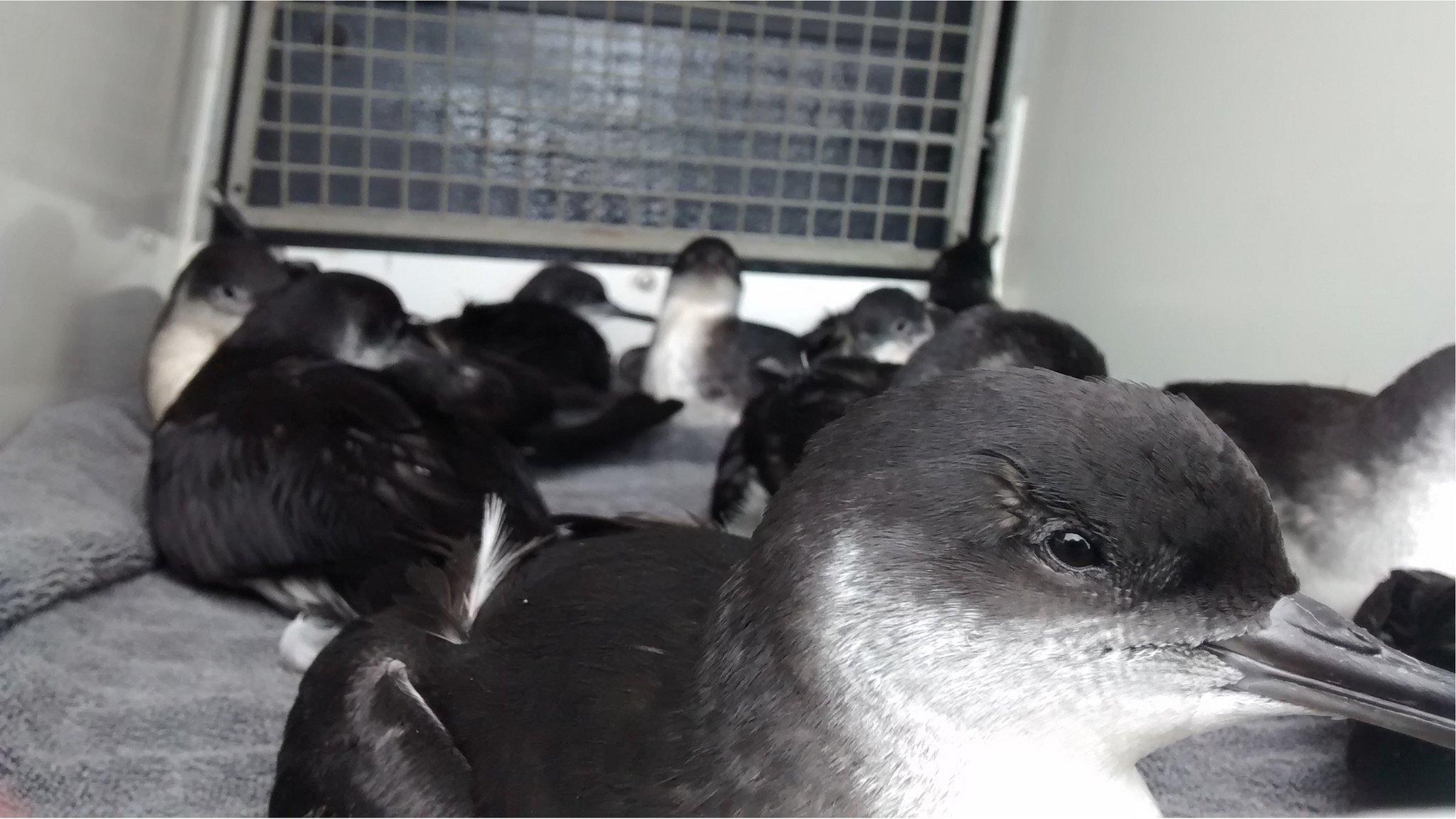Manx shearwater: The Skomer bird which appears after dark
- Published
Natasha Gillies explains the process of weighing the chicks
They are arguably one of Wales' most extraordinary and important birds - but you have to go out at night for the best chance to see them.
Skomer Island off the Pembrokeshire coast is home to half the world's population of Manx shearwater.
More than 300,000 pairs of the birds breed on the colony - but can only return to feed their chicks under the cover of darkness.
Researchers have completed a latest census of the population.
It is hoped in the coming weeks conservationists will know whether the birds are still doing well in terms of numbers.
Scientists from Oxford University are also involved in a long-running project. And using tiny logging devices on the birds, they're hoping to learn more about the birds and their behaviour.

Why are they special?
The shearwater migrates every year 7,000 miles (11,200km) to the coast of South America - spending our winter feeding at sea - but returns, often to the same part of the island and sometimes to the same burrow, to breed again in the spring
New research suggests they may use a "sun compass" to help them navigate back to Skomer., external
Although it lays only one egg a year, shearwater can have long lives and breed for many years. The longest living was recorded at over 50 years of age
Chicks grow larger than their parents - before getting to "flight weight" to make their first, solo journey to South America - before returning to Skomer as adults

Skomer Island, managed by the Wildlife Trust of South and West Wales, is a beautiful haven for wild birds and its cliffs and one-time farmland is pock-marked with burrows on the four-mile walk.
Visitors flock on boats during late spring and early summer to see thousands of puffins, also an important colony.
But by mid-August the puffins have gone and once the last boats have left and the sun sets on the island, Skomer comes alive.
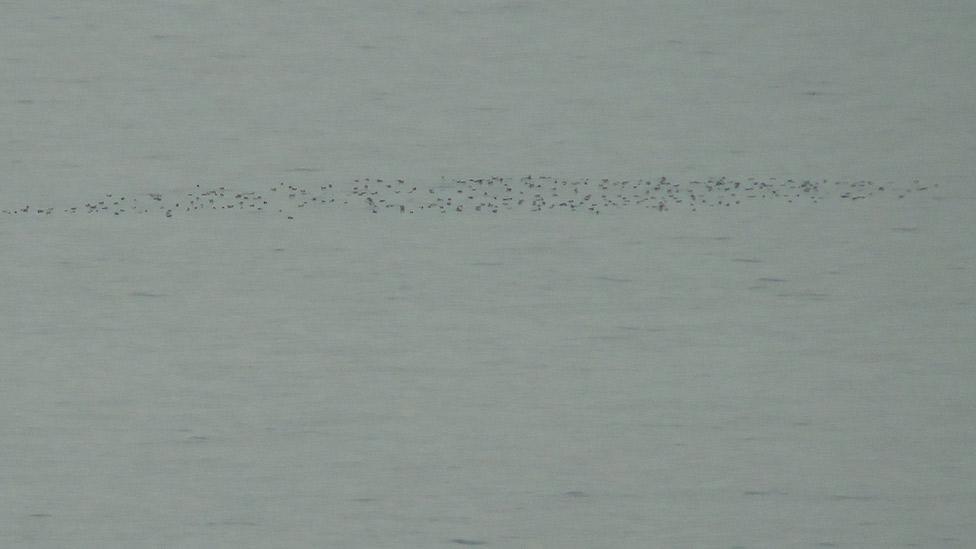
Manx Shearwater adults rafting off the coast of Skomer - waiting until nightfall to safely return to feed their chicks
Manx shearwater raft on the sea just off the island before dusk and then on moon-less nights - the best conditions to avoid predatory black-backed gulls - they return to their underground nests in their thousands.
Overnight visitors to the Trust's farmhouse hostel trek out with torches and within a few yards you can hear the screech and call of the shearwater, as they head back to feed their chicks.
With birds flying in above your head, at all angles, Skomer feels like wandering around a busy airport runway at night, with the lights turned off and air traffic control staying at home.
The Manx shearwater - seen with a night lens
After two overnight visits to see these otherwise elusive birds in the last year, this time I went along with a cameraman with a night vision lens to try to see even more of them.
With legs set back and apart, they are cumbersome on land and you can spot them waddling about at the burrow entrances and along the paths.
This would leave them vulnerable on the mainland. But Skomer's success is due to the lack of land predators, such as foxes and stoats, while the Trust is strict about ensuring no visitors bring rats to the island in their backpacks by mistake.
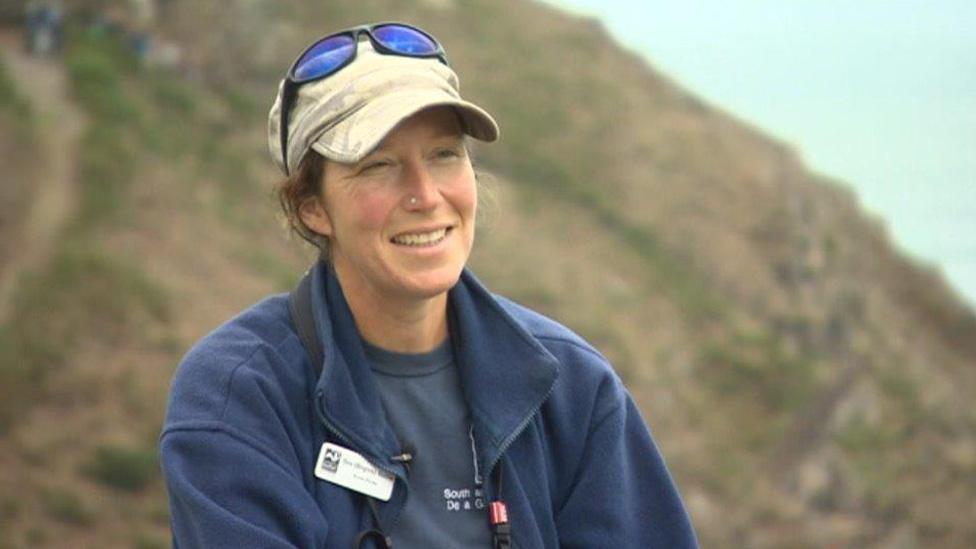
Warden Birgitta Buche said the birds would "waddle past " them on their walks at night
Birgitta Buche, known as Bee, will leaving Skomer next month after six years as joint warden with her partner Ed Stubbings.
"For me personally, they're the best creatures on the island," she said.
"I know everyone loves puffins, they're very cute, but the shearwaters' entire lifestyle and also the fact you can only see them at night, makes them really special, exciting and it feels likes a real adventure to go out to see them."
Their contact with humans is so rare, they appear to have little fear when they do meet one.
"We're such a strange, odd concept to them that they just ignore us and when you go for walks at night, they just waddle past," she said.
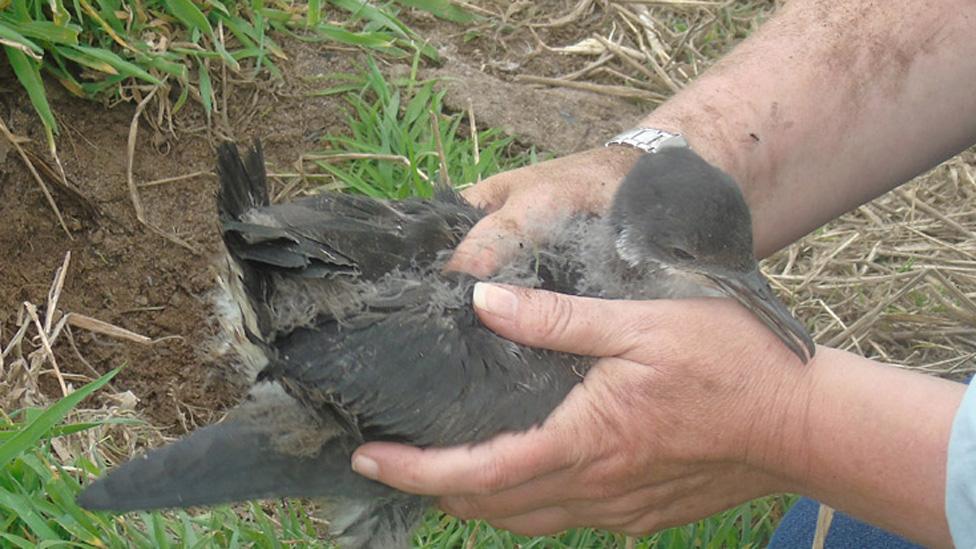
This Manx Shearwater chick - pictured a year ago - will now hopefully be maturing off the coast of Argentina
Every day, 100 chicks are weighed right up until they fledge, around 70 days after hatching.
Natasha Gillies, one of four researchers from Oxford University's department of zoology on the island, said the "masses of fluff and fat" meant they were heavier than their parents.
"Two weeks before they actually fledge, their parents will abandon them and stop feeding them altogether and in this time they turn all that fat and food into feathers and muscle," she said.
"Then they'll take off without their parents, having never left their burrow before, and fly off to Argentina."
Shearwaters lay one egg a year. While one parent feeds the chick - the other is away on longer trips to feed themselves.
A burrow cam on Skomer Island shows Manx shearwaters mating - and preening each other - underground.
Researchers believe the parents take it in turns. The longer trips can be for a week or more, often to waters off Scotland or the Isle of Man but one bird has just been detected just south of Iceland - on a round-trip which took 15 days.
There are problems for some of the young shearwaters on their first migratory flight, from the end of August.
Last year, storms blew hundreds onto beaches.
But the newly-fledged chicks can also get confused by lighting from nearby towns and also the refinery and power companies on the Pembrokeshire coast. As they are so clumsy on land, some need rescuing and helped on their way.

Martyna Syposz near some of the burrows being monitored as part of the ongoing research
Another Oxford scientist Martyna Syposz, studying the birds and the effect of light intensity has on shearwater navigation for her PhD, said the reason they were attracted to the lights was not yet known.
"It could be attraction or they could be disorientated, so one of my questions I'm trying to answer is why they're coming to the light polluted areas," she said.
It might be one day a solution could be offered to develop lighting which is more shearwater-friendly.
What to do if you find a stranded shearwater in Pembrokeshire, external
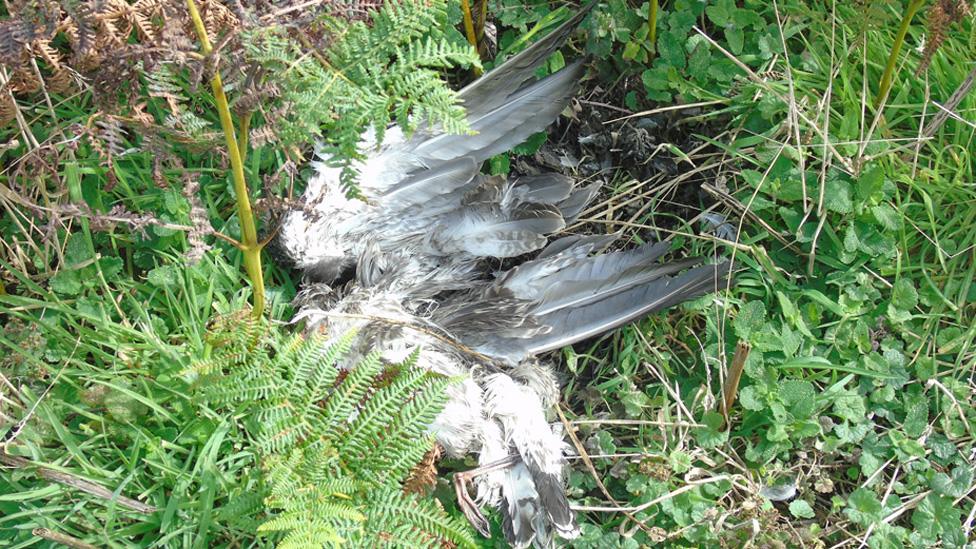
While land predators have been eradicated from Skomer, there is always a danger to Shearwater from gulls
As satellite tracking devices - transmitting back information - would be too heavy for birds like shearwater, miniature chips and tags are attached to the birds to give an insight into their lives.
Fifty birds have tiny tags which measure roughly where they're migrating to and tags with micro-chips are also being used on 140 birds and 70 burrows to learn more about how the parents feed their chicks and communicate.
Prof Tim Guilford, who is leading the project, said: "By following individual shearwaters for year after year we have managed to show how the efforts of bringing up a chick affect future behaviour in the following year," he said.
"And we can see the bird working harder all through the winter to regain condition, even though it is somewhere in the southern ocean."
Sarah Parmor, Skomer visitors' officer, explains how recordings of shearwater calls are played during the census
Results from the latest census are being collated and analysed over the next few months.
Meanwhile, Prof Guilford is hoping GPS logging will continue to give information about where the birds are feeding, and how that responds to any changes.
"Ultimately we are hoping to understand enough about these extraordinary birds to know what matters to them and how they will fare as the oceans change," he said.
Bee will miss her noisy neighbours - even the one which once got inside her room and wrapped itself in her curtain - and believes shearwaters are underappreciated.
She is also hopeful that despite their vulnerability, they will continue to prosper.
"They should not just be Wales' national bird but a British national bird because the most important populations on the planet live here. Their burrows, with the puffins and rabbits too, have shaped the entire island," she said.
- Published31 July 2018
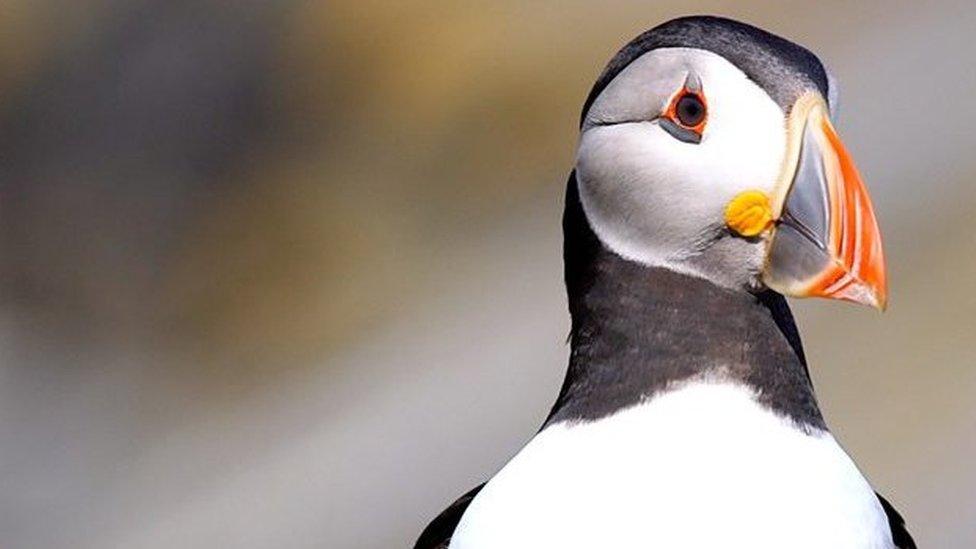
- Published26 June 2018
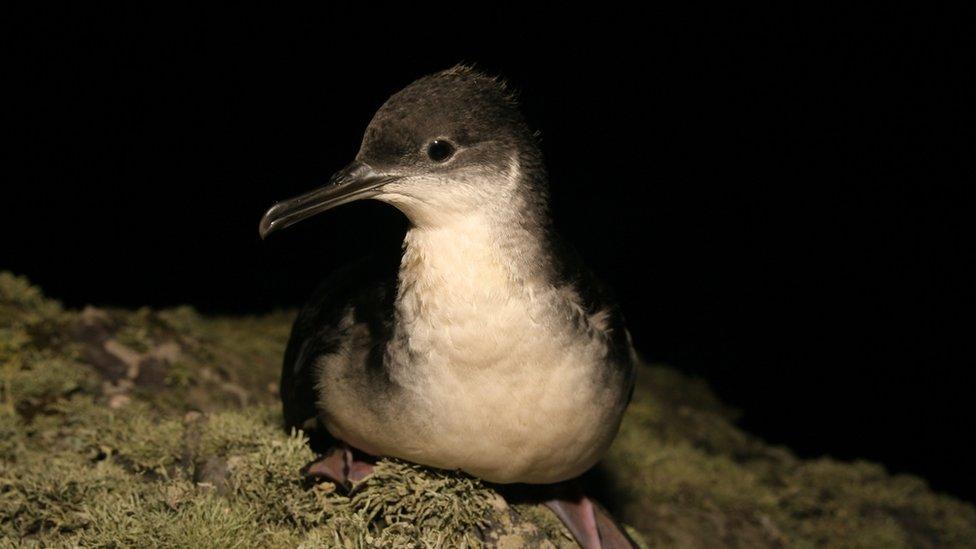
- Published11 September 2017
